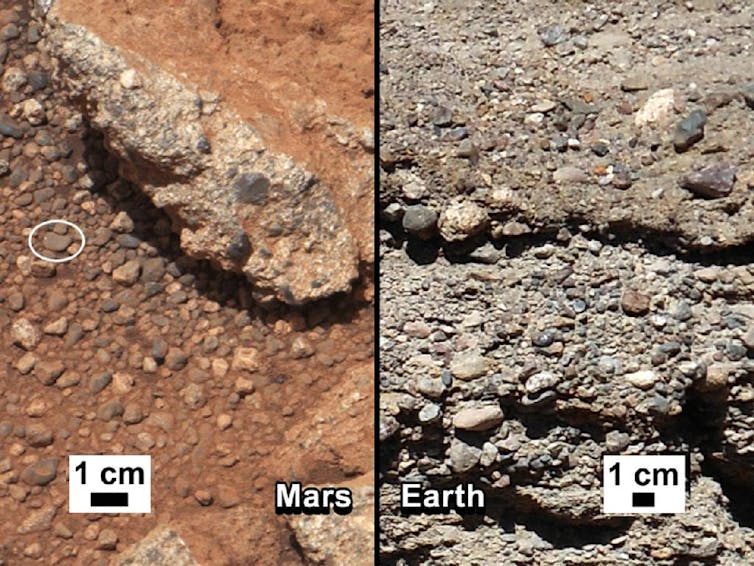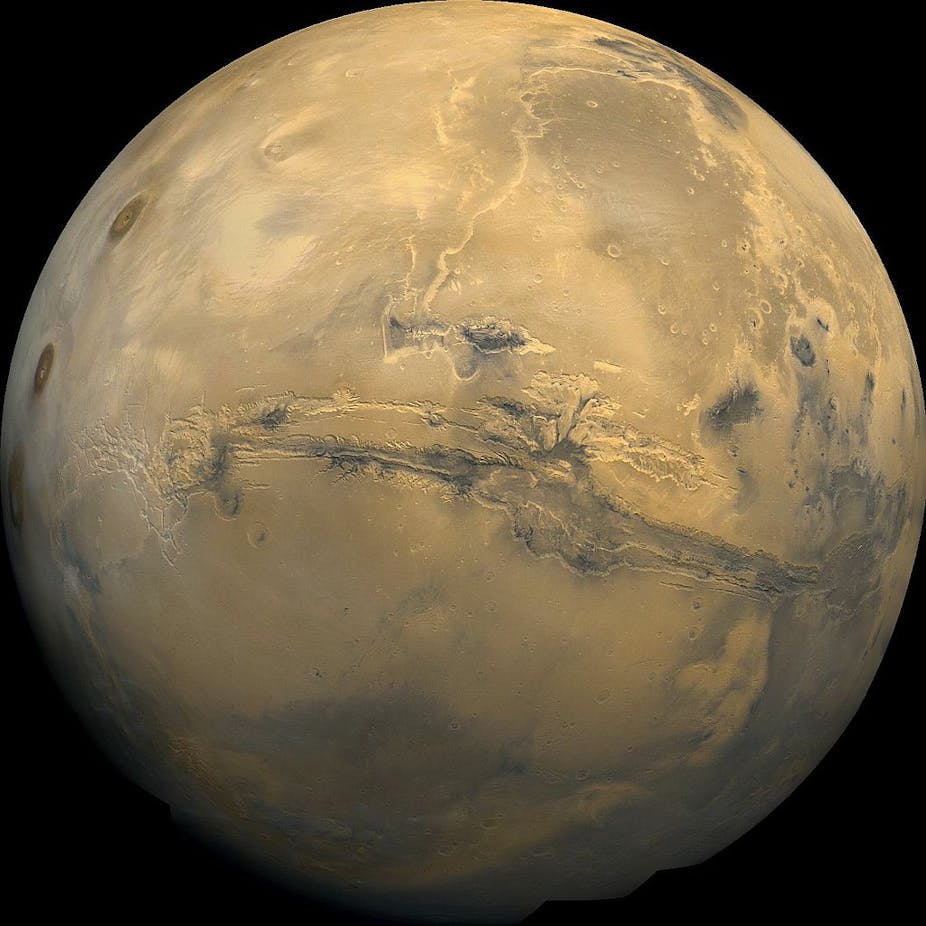In an announcement today, NASA poured cold water on rumours that its Curiosity rover had found life on Mars.
Curiosity found evidence that it had landed on an ancient riverbed, and it identified some interesting chemical species involving chlorine, sulphur, water and organic compounds, but nothing that could be construed as clear-cut evidence for life on Mars, past or present.
All of this underscores Carl Sagan’s caution, reiterated in his final book Billions and Billions, that extraordinary claims require extraordinary evidence.
And even if one day NASA does find such evidence, this would only raise the question as to whether we are all Martians, since (as we shall discuss below) life on Earth may have originated on Mars.

Search history
The current search for life on Mars is the latest of a series of observations (and controversies) extending back to the 1970s. In 1976 NASA’s Viking spacecraft performed an experiment that produced tantalising results, but which were subsequently interpreted as not indicative of life, because a second experiment to confirm biological activity was negative.
But some researchers were never satisfied with this conclusion.
Interest in these results was revived in September 2010, when scientists analysing results of NASA’s Phoenix mission in 2008 found that a highly reactive perchlorate compound was present in the Martian soil. Since the Viking spacecraft had heated its samples to high temperature, it is likely that organic material, if present, would have been destroyed in the process.
In other words, the original 1976 “no organics present” conclusion was drawn sharply into question by the existence of this perchlorate compound in the Martian soil.
Martian meteorites have also yielded tantalising suggestions of biological activity. It has been known for some time that roughly 1 billion metric tons of material has been exchanged between Mars and Earth. And at least 60 individual Earth meteorites have been identified as of Martian origin, due to isotopic similarities with rocks studied by Mars landers.
In 1996, NASA scientists David McKay and Everett Gibson announced evidence that the ALH84001 meteorite, which had previously been established as having originated on Mars, may have once fostered living organisms (thus suggesting, among other things, that meteorites from Mars may indeed have seeded life on Earth).
The following photo shows structures reminiscent of primitive bacteria:

But other scientists were not convinced. They argued that these structures could have arisen from inorganic carbonate materials decomposing under high temperatures.
The debate erupted anew in 2009, when McKay’s team argued that there was no plausible geological scenario that could explain the results. Final resolution of this dispute will most likely need to await the Mars sample return mission, which, sadly, has been postponed until the mid- to late-2020s.
On the other hand, NASA is no longer the sole player in the space business: the European Space Agency is planning Mars robot missions, and commercial enterprises such as SpaceX and Orbital Sciences may join as well.
Along this line, on July 18, 2011 a Martian meteorite landed in the Moroccan desert. Because it was found when it was still “fresh,” scientists were able to determine that it contained evidence of past water on Mars, although it had no other clear indicators of life.
The Curiosity spacecraft itself has found evidence that its Mars landing site was once covered with fast-moving water.
Fermi’s paradox
Ever since the dawn of civilization, mankind has gazed into the night sky and wondered if there are other sentient creatures in the cosmos. Even in our time, the SETI project has scoured the skies, using some of the most advanced equipment our high-tech society can generate, for any signals or evidence that would suggest there are other technological civilisations in our galaxy. So far all of these searches have been in vain.
In the past few months, scientists have discovered numerous exoplanets in the “habitable zone” about their respective suns. But scientists have not yet found credible evidence that any of these planets are inhabited by life, let alone intelligent creatures.

One day in 1950, nuclear physicist Enrico Fermi (1901-1954), while chatting with colleagues about a cartoon they had seen depicting space aliens in New York City, suddenly blurted out: “Where is everybody!?”
His reasoning was that if a technological society exists anywhere in the Milky Way galaxy, then surely after millions of years at least some small band of its citizens would have ventured to the stars, and, after a few million more years, would have fully colonised the galaxy by now.
But there is no scientific evidence that these aliens exist — no space probes in our neck of the woods, and no discernible communication either.
Are we alone?
In the years since 1950, as we have discussed recently on The Conversation, scientists have analysed every aspect of Fermi’s paradox — as this question is now known – in great detail. But there are still no easy answers.
Suggestions that extraterrestrials have lost interest in space travel and interstellar communication founder on the realisation that it seems exceedingly unlikely that each and every member of each and every distant civilisation, over many millions of years, lacks interest.
All it takes is for one small group, at one point in cosmic time, to reach for the stars (using technology that is doubtless far ahead of ours), and this “solution” fails.
Panspermia
One possible solution to Fermi’s paradox is “panspermia,” namely the notion that life has emerged somewhere outside the solar system and has spread throughout the cosmos via bacterial spores, which were the “seeds” of life on Earth. Early modern advocates included English astronomer Fred Hoyle (1915-2001).
But as American astronomer Caleb Scharf has pointed out, there are problems with this theory too, not least that it merely pushes the question of the origin of life to some other planetary system.
Starting in the 1960s, DNA co-discoverer Francis Crick advocated a more audacious directed panspermia (meaning that life was seeded on Earth by intention). At the time, he underestimated the possibilities for independent biogenesis.
On the other hand, random panspermia within the solar system may well be the origin of life on Earth, since, as mentioned above, life on Earth may have arrived from Mars via meteorites. If so, we really are all Martians!

Along this line, American biologist and entrepreneur Craig Venter has announced plans to send a DNA sequencer to Mars. Such a device may finally determine whether life, if any is found on Mars, is derived from Earth, or we are derived from Mars, or the two are independent.
If Martian life is found, and if it is confirmed to be independent from Earth life, this is truly a significant result, as it confirms Nobel Prize-winning cytologist and biochemist Christian De Duve’s suggestion that there is a cosmic imperative of sorts for life.
But such a finding would also further deepen Fermi’s paradox. If life independently arose twice, just in our own solar system, then where is everybody else?
A previous version of this article appeared on Math Drudge.
Further reading:
- NASA’s Curiosity shows there’s more to life than life – Kevin Orrman-Rossiter & Helen Maynard-Casely, The Conversation

